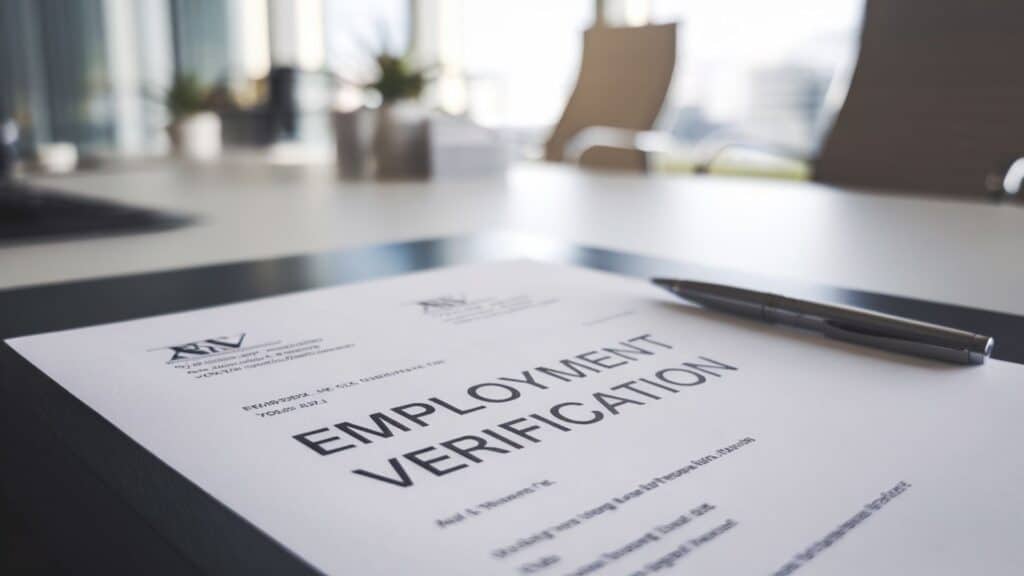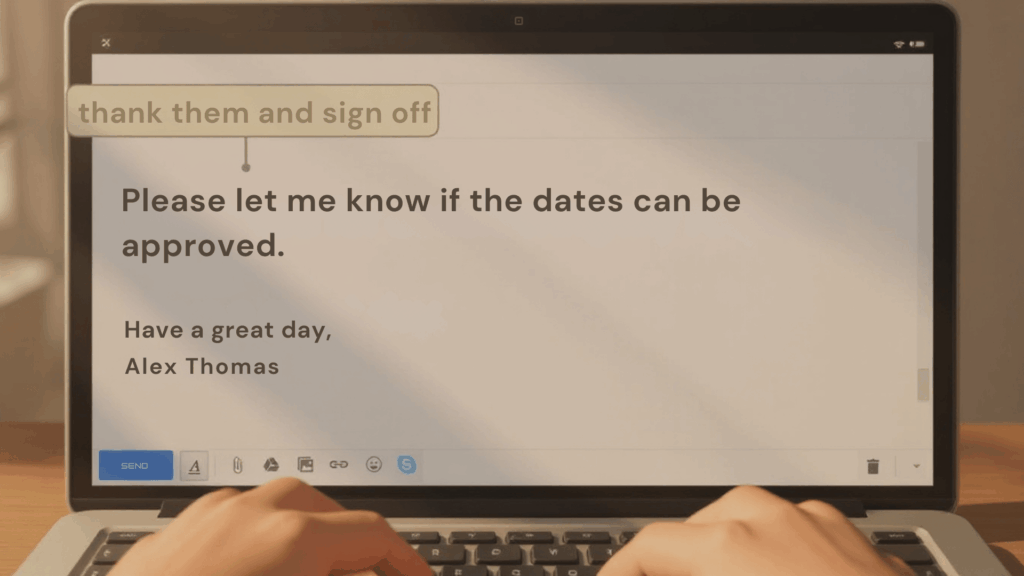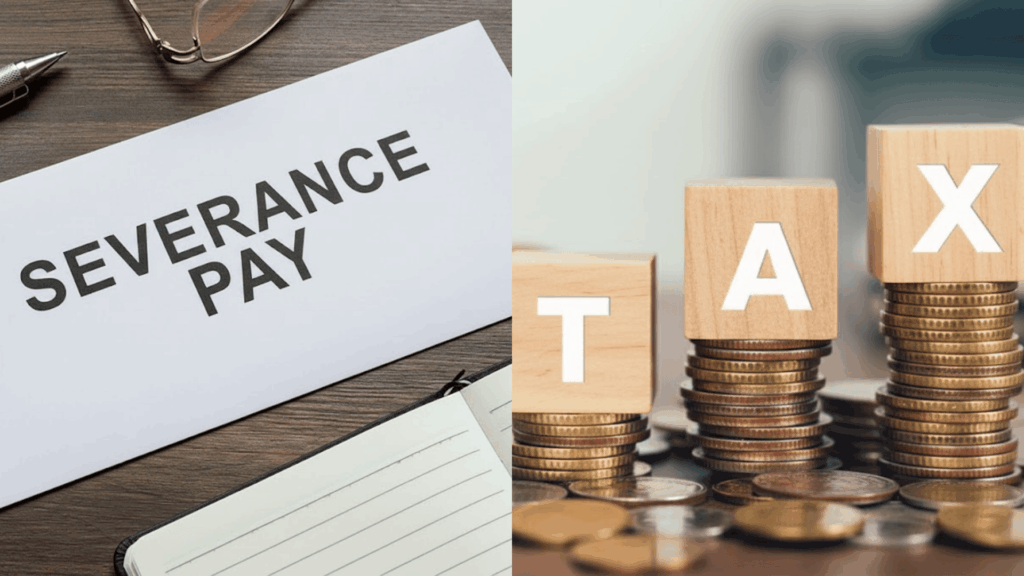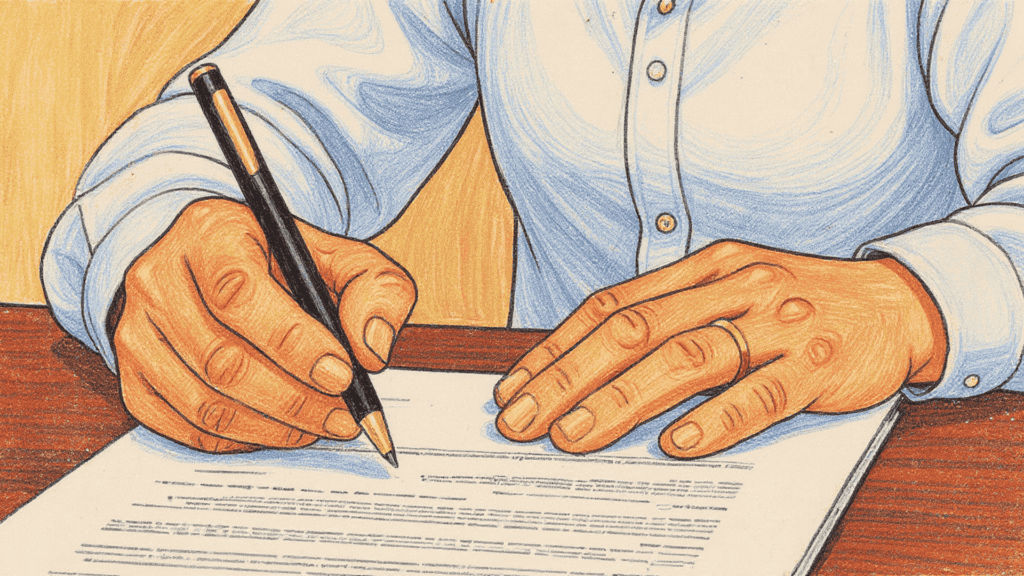Need to rent an apartment, apply for a loan, or get a visa?
You’ll likely need an employment verification letter sample. This official document proves your job status and income to third parties.
Many people struggle with writing or requesting these letters.
HR teams often become overwhelmed with requests, while employees struggle to determine what details to include.
Here, you will learn how to create professional employment verification letters.
You’ll learn key components, step-by-step writing tips, common mistakes to avoid, and get a downloadable template.
What is an Employment Verification Letter?
An employment verification letter is a formal document that confirms a person’s employment status, salary, and work history.
Companies write these letters to verify that someone is currently employed by them or has worked there in the past.
The letter serves as proof of employment for third parties, such as landlords, lenders, or government agencies.
It contains factual information about the employee’s position, start date, current employment status, and, in some cases, salary details.
Common Reasons for Requesting One
People need employment verification letters for several important situations:
- Rental applications – Landlords want proof of steady income before approving tenants
- Loan applications – Banks and lenders verify employment before approving mortgages or personal loans
- Visa applications – Immigration offices require proof of employment for various visa types
- Background checks – New employers may verify previous work history
- Government assistance programs – Social services verify income for benefit eligibility
- Child support cases – Courts need income verification for support calculations
The letter acts as an official stamp of approval from your employer.
It gives requesting parties confidence that the information provided is accurate and trustworthy.
Want to make your next interview feel natural and still land the job? Learn the informal questions that really work. Informal Interview Questions That Actually Get You Hired
Key Components of an Employment Verification Letter
Every professional employment verification letter must include specific information to be valid and useful.
Missing any of these key components could result in delays or the rejection of applications.
1. Employee’s Personal Information
- Full legal name (as on official documents)
- Current job title or position
- Employee ID number (if applicable)
- Department or division
2. Employment Details
- Employment start date (Month Day, Year)
- Current employment status (active, on leave, terminated)
- End date (if no longer employed)
- Work schedule (full-time, part-time, or hours per week)
- Annual salary or hourly wage (only if requested and permitted)
3. Company Information
- Full legal company name
- Complete business address (street, city, state, ZIP)
- Company phone number and website (if applicable)
- Business registration or tax ID numbers (if required)
4. Signature and Contact Details
- Name and title of authorized signatory (HR manager, supervisor, or executive)
- Handwritten or approved electronic signature
- Date the letter was issued
- Direct contact information (phone/email)
- Use of official company letterhead or company stamp
How to Write an Employment Verification Letter?
Writing a professional employment verification letter follows a simple structure.
Follow these steps to create a document that serves its purpose effectively and looks professional:
Step 1: Start with a formal greeting
Use “To Whom It May Concern” when you don’t know the recipient’s name. If you know who will read the letter, address them directly with “Dear [Name]” or “Dear Loan Officer.”
Step 2: Write a clear opening statement
Begin with “This letter confirms the employment of [Employee Name]” or similar direct language. State the purpose of the letter in the first sentence.
Step 3: Provide employment verification details
Include the employee’s current position, department, and employment status. Mention the supervisor’s name if it is relevant to the request.
Step 4: Add work performance context when appropriate
Note if they work remotely, have flexible hours, or hold any special certifications required for their role. This helps explain their work situation better.
Step 5: Close with availability for questions
End by offering to provide additional information if needed. Include a professional closing, such as “Sincerely” or “Best regards.”
Step 6: Format properly before sending
Use standard business letter spacing and margins. Save the document as a PDF to preserve formatting when emailing it.
Learn the simple steps to tailor your resume for every job you apply to. How to Tailor Your Resume to Job Descriptions?
Employment Verification Letter Sample Template
Use this professional template as a starting point for creating your own employment verification letters.
Simply fill in the bracketed sections with the appropriate information for each request.
|
[COMPANY LETTERHEAD] [Company Name] [Street Address] [City, State ZIP Code] [Phone Number] [Email Address] [Date] To Whom It May Concern: This letter serves to verify the employment of [Employee Full Name] with [Company Name]. The following information is provided for your verification purposes: Employee Information:
Employment Details:
[Employee Name] has been a reliable and valued member of our team. Their employment with our company remains in good standing as of the date of this letter. If you require any additional information or have questions regarding this verification, please contact me directly at [Phone Number] or [Email Address]. Sincerely, [ Signature] [Printed Name] [Job Title] [Company Name] [Direct Phone Number] [Email Address] |
Sample Templates as per Requirements
The following sample templates demonstrate how to write professional employment verification letters for different purposes.
Download these templates in PDF format by clicking here.
1. Rental Application
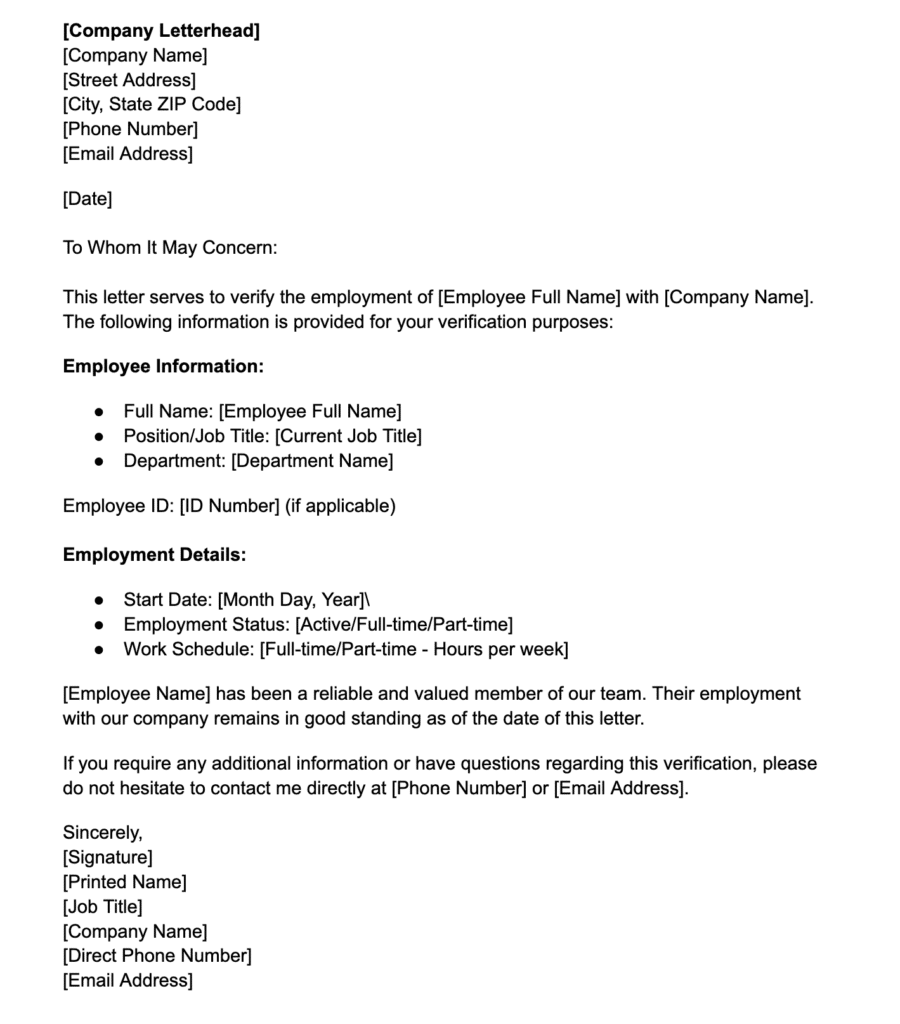
2. Loan Application
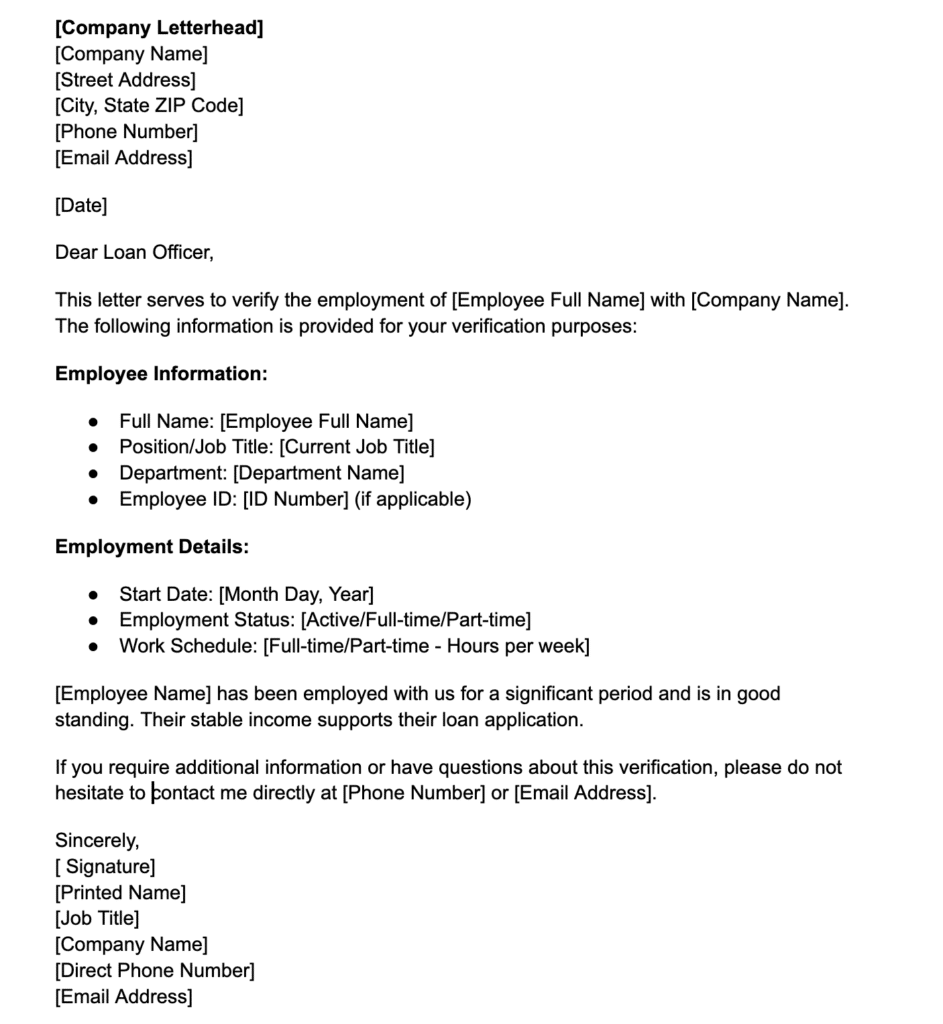
3. Visa Applications
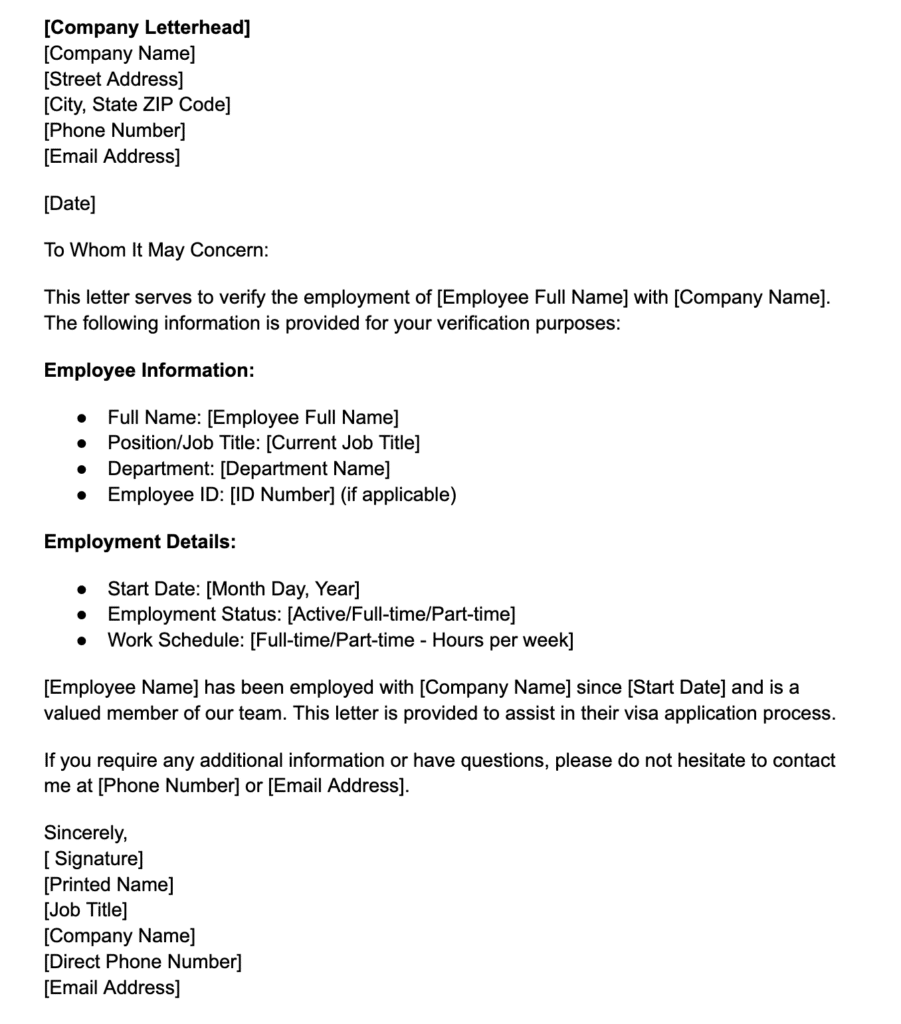
4. Background Checks
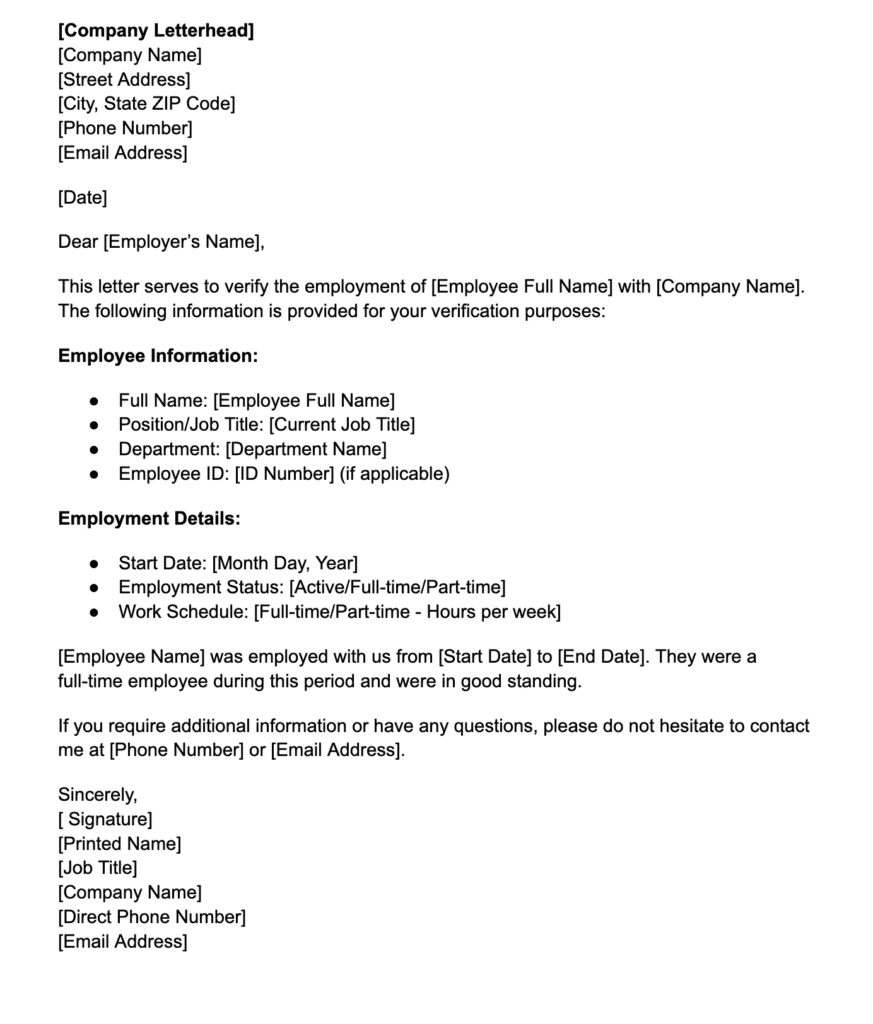
5. Government Assistance Programs
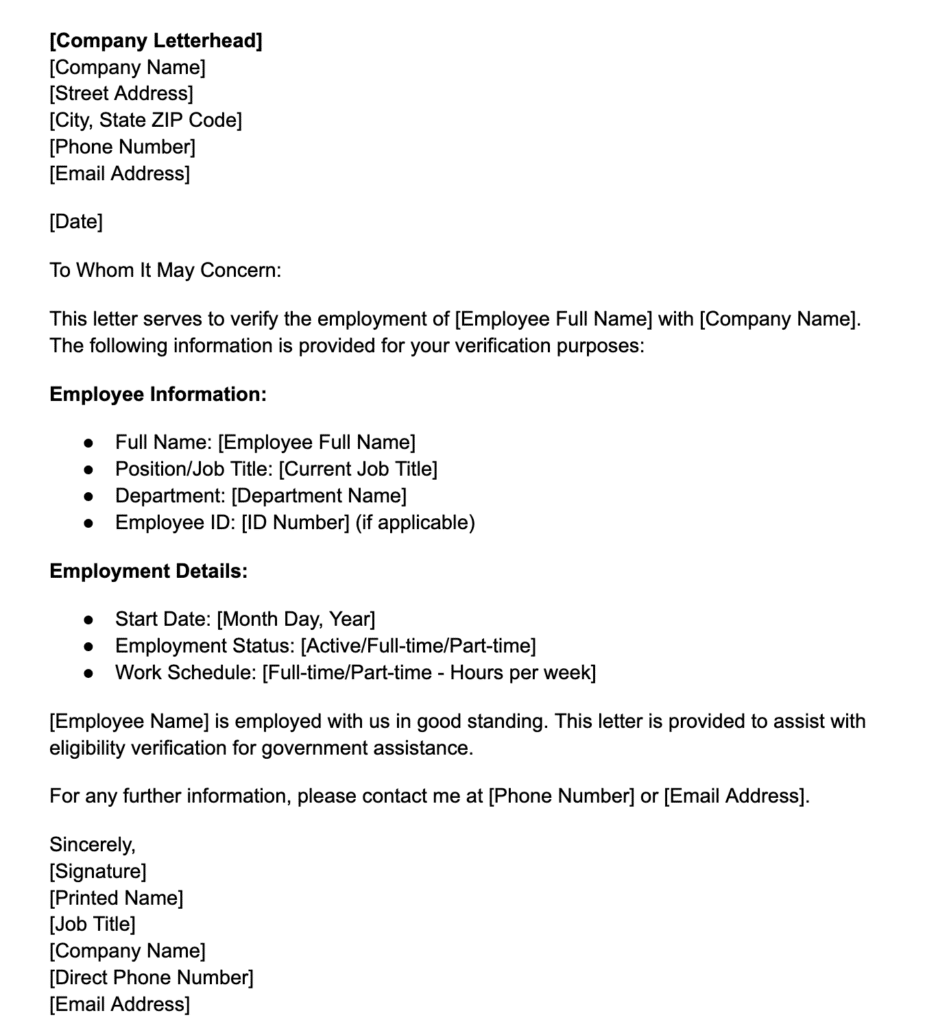
6. Child Support Cases
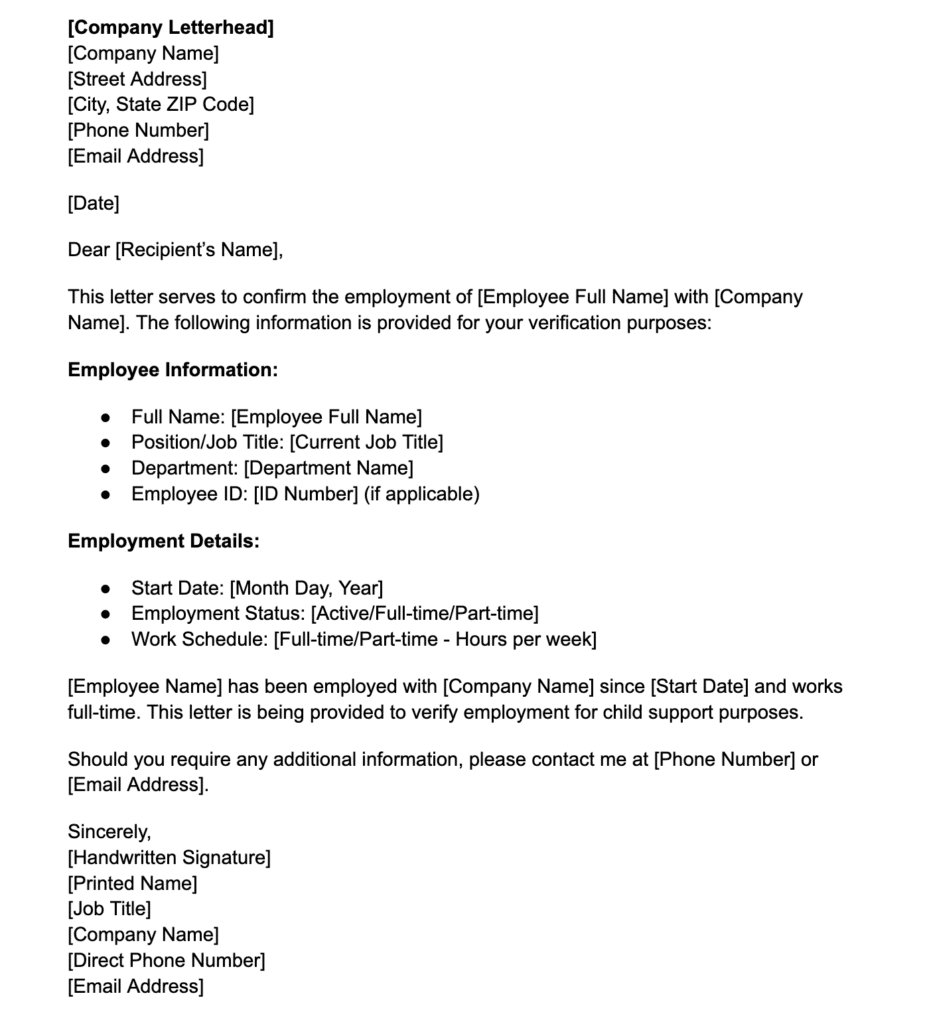
7. Bank Loan
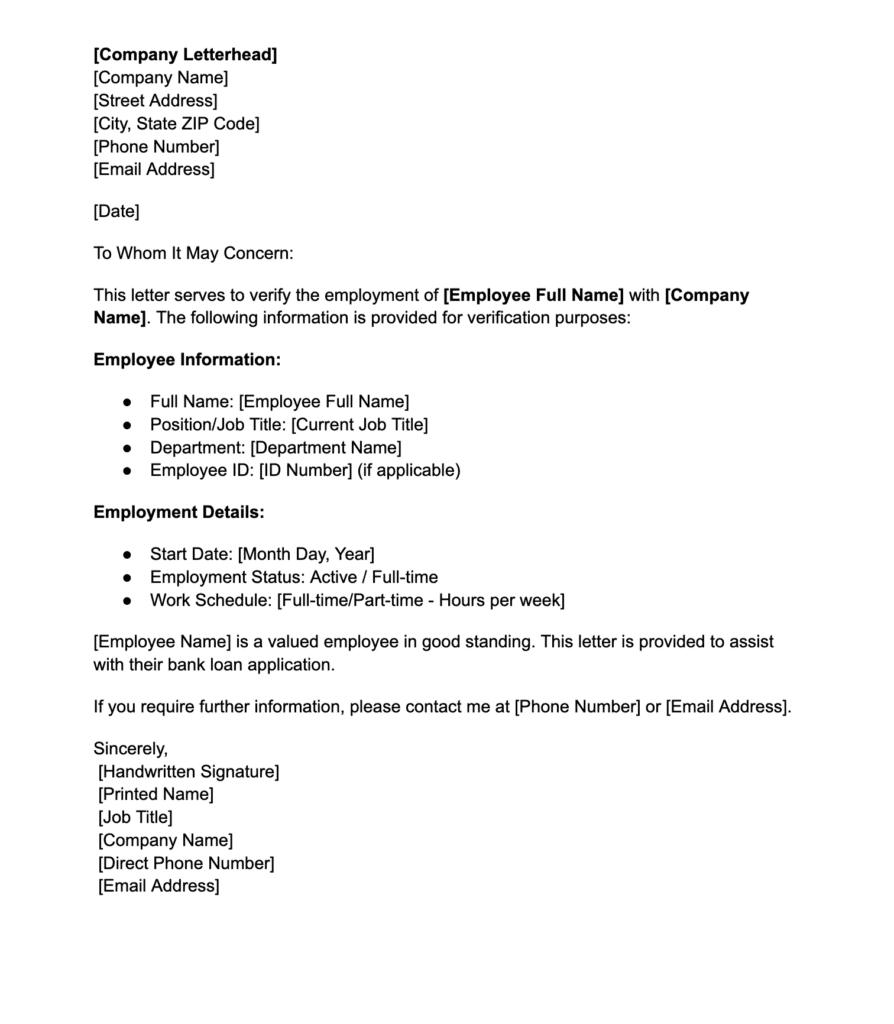
8. Immigration
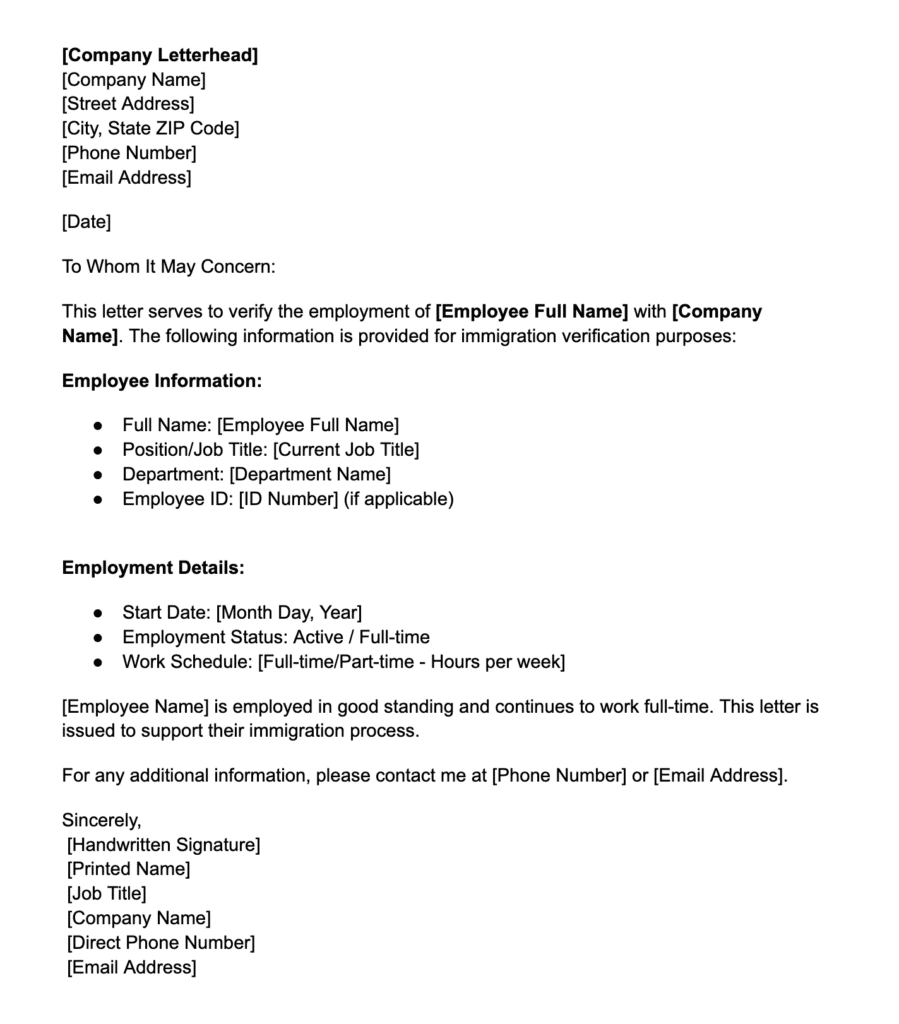
9. Green Card
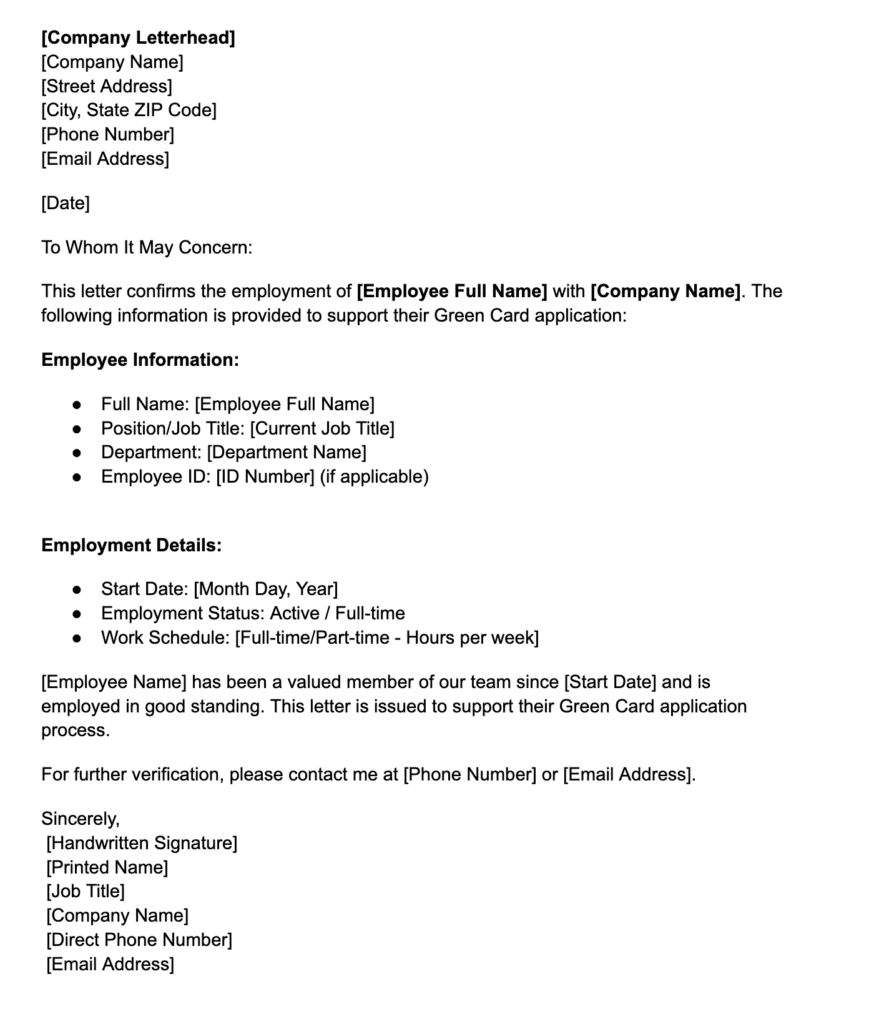
Read and know more about: How Many Bullet Points per Job on a Resume?
Tips for Professional and Clear Letters
Writing an effective employment verification letter requires professionalism, clarity, and consistency.
Following these tips ensures your letter is accurate, formal, and meets verification needs.
- Maintain consistent formatting throughout the document, including proper spacing and alignment.
- Print on quality paper or send as a PDF to maintain a professional appearance.
- Respond to verification requests within 2–3 business days whenever possible.
- Quick responses help employees meet important deadlines for loans, rentals, or applications.
- Create a standard template for your organization to ensure consistency and reduce errors.
- Keep your language neutral and factual, avoiding emotional or subjective words.
- Stick to measurable details like employment dates, job titles, and responsibilities.
What to Avoid?
Certain information and practices can make a verification letter unprofessional or legally risky. Avoid these common mistakes to maintain credibility and compliance.
- Don’t include confidential salary information without written permission.
- Never share details about medical leave, workers’ compensation claims, or disability accommodations.
- Avoid writing letters for former employees you didn’t directly supervise.
- Don’t make statements about future job security or company plans.
- Never backdate letters or alter employment dates to support an application.
- Don’t sign blank letterhead that others might fill in later.
Conclusion
Writing a professional employment verification letter doesn’t have to be complicated when you follow the right structure.
Remember to include all key components: employee details, employment information, company data, and proper signatures.
Keep your language factual and concise, avoiding personal opinions and confidential details.
A well-written letter makes the process smoother for everyone involved, regardless of the purpose.
Download our free template now and start creating professional employment verification letters today!
Frequently Asked Questions
Can I Request an Employment Verification Letter from a Previous Employer After Several Years?
Yes, most companies keep employment records for 3-7 years. Contact HR directly with your full name, employment dates, and reason for the request.
Can Employment Verification Letters Be Used Internationally for Visa or Immigration Purposes?
Yes, but international applications may require additional authentication, such as notarization, apostille certification, or translation into the destination country’s official language.
How Long do Verification Letters Remain Valid for Applications?
Most requesting parties prefer letters dated within 30 to 90 days of the application submission date. Older letters may be rejected and require updated versions from employers.

